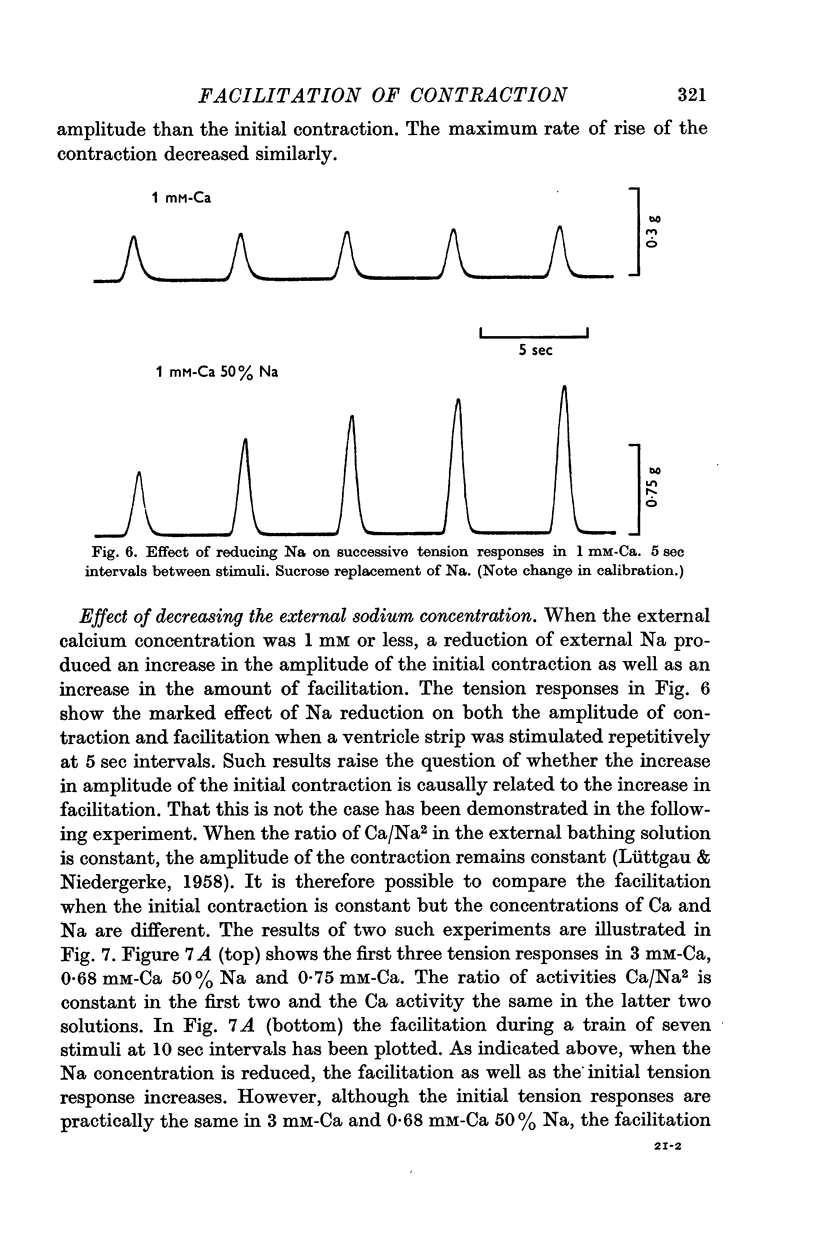Abstract
1. The magnitude and time course of the facilitation of contraction following previous stimulation have been studied in strips of frog ventricle when the external concentrations of Na and Ca were varied. The maximum tension and the maximum rate of rise of tension have been used as indices of activation of the contractile element. Under the experimental conditions these two parameters changed similarly.
2. At low stimulus frequencies (3-12 beats/min), and moderate concentrations of external Ca (2-5 mM), the facilitation of contraction with repetitive stimulation can be predicted by assuming each contraction to produce an amount of facilitation which sums linearly with that remaining from previous responses. Thus, the staircase can be constructed from the decay of facilitation following a single contraction.
3. The decay of facilitation appears to consist of two components. The first has a half-time of about 3 sec; the second about 50 sec. The decay of the second component of facilitation is slowed and its magnitude increased by raising the external Ca from 2 to 5 mM.
4. Reducing the external Na concentration increases both the initial strength of contraction and the amount of facilitation.
5. When the ratio Ca/Na2 is kept constant while changing the Ca and Na concentrations, the first contraction in a series remains constant, but facilitation is less at low concentrations of Ca and Na. Facilitation, therefore, does not depend solely on the amount of initial activation of the contractile system.
6. The results are consistent with the hypothesis that facilitation depends on the amount of calcium retained in some cellular store.
Full text
PDF














Selected References
These references are in PubMed. This may not be the complete list of references from this article.
- Brady A. J., Woodbury J. W. The sodium-potassium hypothesis as the basis of electrical activity in frog ventricle. J Physiol. 1960 Dec;154(2):385–407. doi: 10.1113/jphysiol.1960.sp006586. [DOI] [PMC free article] [PubMed] [Google Scholar]
- Dale A. S. The staircase phenomenon in ventricular muscle. J Physiol. 1932 May 30;75(1):1–16. doi: 10.1113/jphysiol.1932.sp002868. [DOI] [PMC free article] [PubMed] [Google Scholar]
- KOCH-WESER J., BLINKS J. R. THE INFLUENCE OF THE INTERVAL BETWEEN BEATS ON MYOCARDIAL CONTRACTILITY. Pharmacol Rev. 1963 Sep;15:601–652. [PubMed] [Google Scholar]
- LUTTGAU H. C., NIEDERGERKE R. The antagonism between Ca and Na ions on the frog's heart. J Physiol. 1958 Oct 31;143(3):486–505. doi: 10.1113/jphysiol.1958.sp006073. [DOI] [PMC free article] [PubMed] [Google Scholar]
- Mallart A., Martin A. R. An analysis of facilitation of transmitter release at the neuromuscular junction of the frog. J Physiol. 1967 Dec;193(3):679–694. doi: 10.1113/jphysiol.1967.sp008388. [DOI] [PMC free article] [PubMed] [Google Scholar]
- NAYLER W. G. The importance of calcium in poststimulation potentiation. J Gen Physiol. 1961 Jul;44:1059–1072. doi: 10.1085/jgp.44.6.1059. [DOI] [PMC free article] [PubMed] [Google Scholar]
- NIEDERGERKE R. MOVEMENTS OF CA IN FROG HEART VENTRICLES AT REST AND DURING CONTRACTURES. J Physiol. 1963 Jul;167:515–550. doi: 10.1113/jphysiol.1963.sp007166. [DOI] [PMC free article] [PubMed] [Google Scholar]
- NIEDERGERKE R. Movements of Ca in beating ventricles of the frog heart. J Physiol. 1963 Jul;167:551–580. doi: 10.1113/jphysiol.1963.sp007167. [DOI] [PMC free article] [PubMed] [Google Scholar]
- NIEDERGERKE R. The staircase phenomenon and the action of calcium on the heart. J Physiol. 1956 Dec 28;134(3):569–583. doi: 10.1113/jphysiol.1956.sp005666. [DOI] [PMC free article] [PubMed] [Google Scholar]
- Niedergerke R., Orkand R. K. The dual effect of calcium on the action potential of the frog's heart. J Physiol. 1966 May;184(2):291–311. doi: 10.1113/jphysiol.1966.sp007916. [DOI] [PMC free article] [PubMed] [Google Scholar]


